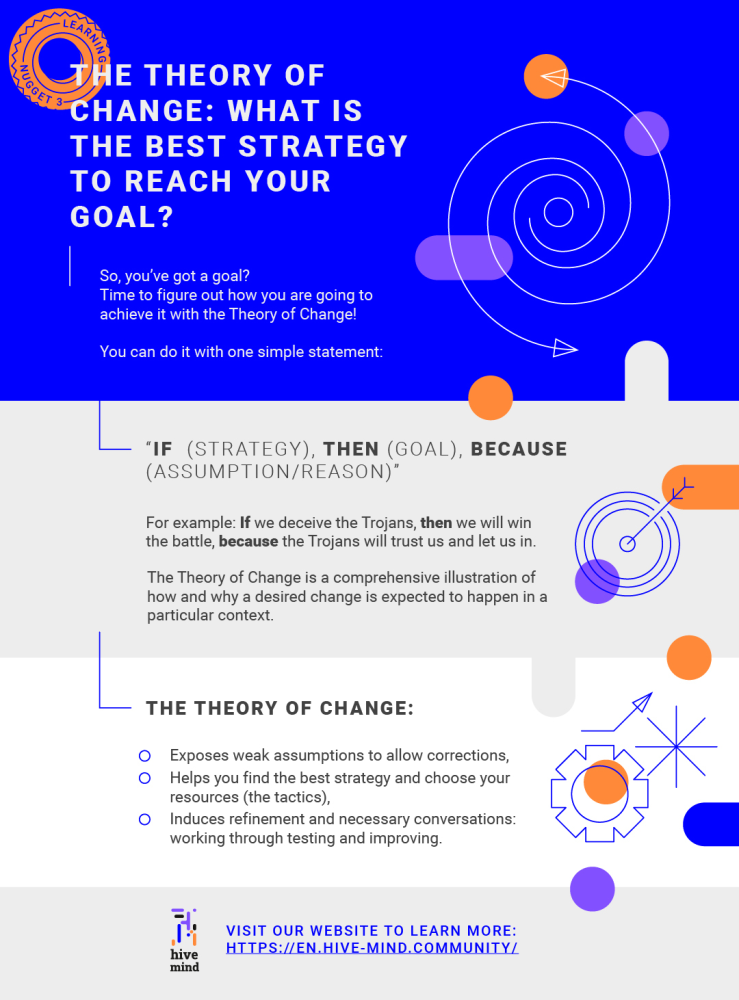The Theory of Change
The Theory of Change is a comprehensive illustration of how and why a desired change is expected to happen in a particular context.
It should explain how in your opinion you can reach your goal and demonstrate at a high level what will need to happen to bring about this change.
The Theory of Change can be best defined as a simple: “if - then - because” statement.
“If (strategy), then (goal), because (assumption/reason)”
Remember the story of The Trojan Horse?
In this case the Theory of Change could look like this:
If we deceive the Trojans, then we will win the battle, because the Trojans will trust us and let us in.
This strategy really relied on the assumption that the Trojans wouldn't look inside the wooden horse. The strategy was to trick them in order to achieve the goal: win the battle.
This strategy has a proven track record. However, you can never be 100% sure if your strategy is correct and will work out. What you can do is to correct it quickly if it's not giving the expected results, or scale it, if it is working out as expected.
The Theory of Change works through refinement.
Differentiate Between Your Goal, Strategy, and Tactics
First, it is good to make sure you correctly define all the elements of your Theory of Change statement.
The Goal is what you're trying to achieve. It is the case you care about, or the point you need to get to.
The Strategy is the method of how you can best achieve this goal. Don’t mistake it with tactics, though! While strategy is your plan for making the change, your tactics are the actions through which your strategy is implemented, e.g., you build a giant wooden horse in order to deceive your enemies or buy a boat to swim down the river.
It's important to figure out your strategy first. If you start with the tactics you risk doing something far less effective or potentially completely useless, e.g., you choose a car as your means of transportation and afterwards you decide the strategy would be to go across the river.
Test Your Assumptions
The benefit of the Theory of Change statement is both concisely summarizing the strategy, and laying bare the assumptions you are relying on.
Your assumptions can be wrong, but you need to start somewhere! It’s important to remember that the Theory of Change is just a theory and like all good theories it needs to be tested and adapted if it doesn’t bring the expected progress.
An example of a common pitfall in campaigning could be:
If people know, then they will act, because knowledge leads to action.
Some campaign strategies are built entirely on this kind of theory of change. Unfortunately, while knowledge is often a precursor to action, it is rarely enough on its own.
Awareness raising can be part of a campaign, but this will rarely lead to long-lasting systemic change.
While creating your Theory of Change you need to ask yourself: is this working out and generating the change? Am I making progress?
If the answer is: “yes”, you should scale up what you are doing for greater impact.
If the answer is: “no”, then you need to use what you have learned in the process to adapt your approach and activities.
Your theory of change, and your campaign is an experiment, and you need to always be testing your assumptions.
To learn more about the Theory of Change, get practical tips on how to choose your strategy, define your leverage points and analyze your context, register for our free, self-paced course: “Online Campaigning – Advanced Course - Part Three” today!
Here's a downloadable infographic summarising the text:

